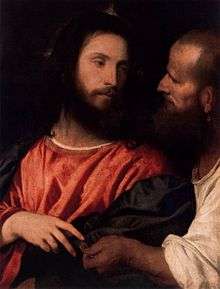Falsche Welt, dir trau ich nicht, BWV 52
Johann Sebastian Bach composed the church cantata Falsche Welt, dir trau ich nicht (False world, I trust you not), BWV 52,[lower-alpha 1] in Leipzig for the 23rd Sunday after Trinity. He led the first performance of the solo cantata for soprano on 24 November 1726.
| Falsche Welt, dir trau ich nicht BWV 52 | |
|---|---|
 The Tribute Money by Titian | |
| Occasion | 23rd Sunday after Trinity |
| Performed | 24 November 1726: Leipzig |
| Movements | 6 |
| Cantata text | |
| Chorale | "In dich hab ich gehoffet, Herr" by Adam Reusner |
| Vocal | |
| Instrumental |
|
History and words
Bach composed the cantata, a solo cantata for a soprano, in 1726 in Leipzig for the 23rd Sunday after Trinity. The prescribed readings for the Sunday were from the Epistle to the Philippians, "our conversation is in heaven" (Philippians 3:17–21), and from the Gospel of Matthew, the question about paying taxes, answered by "Render unto Caesar..." (Matthew 22:15–22). The unknown poet takes from the gospel the idea that the world is false and that man should concentrate on God. He refers to the murder of Abner by Joab, described in 2 Samuel 3:27, as an example for the world's falseness. The closing chorale is the first verse of Adam Reusner's "In dich hab ich gehoffet, Herr" (1533).[1] The beginning line is the last idea of the "Te Deum". Bach used verse 4 of the chorale, "Mir hat die Welt trüglich gericht't", in his St Matthew Passion.
Bach first performed the cantata on 24 November 1726.
Scoring and structure
Bach structured the cantata in six movements and scored it for a soprano soloist, a four-part choir (only for the final chorale), and a Baroque instrumental ensemble of two horns, three oboes, bassoon, two violins, viola, and basso continuo.[2]
- Sinfonia
- Recitative: Falsche Welt, dir trau ich nicht
- Aria: Immerhin, immerhin, wenn ich gleich verstoßen bin
- Recitative: Gott ist getreu
- Aria: Ich halt es mit dem lieben Gott
- Chorale: In dich hab ich gehoffet, Herr
Music
The cantata is set for just one singer, but the instrumentation is rich. Similar to other cantatas of the later Leipzig period, Bach used an instrumental movement from an earlier period as a sinfonia, in this case the music best known as the opening of the first Brandenburg Concerto. This version of the concerto, dominated by horns and oboes, is similar to the sinfonia BWV 1046a (without a violino piccolo and assumed to be an early version of the Brandenburg Concerto).[3][4]
In the first aria the soprano is accompanied by two violins, in the second aria of dance character, by three oboes.
The two horns of the sinfonia return in the closing chorale, horn 1 supporting the soprano, horn 2 playing a fifth part.[2]
Recordings
- J.S. Bach: Das Kantatenwerk – Sacred Cantatas Vol. 3, Gustav Leonhardt, Knabenchor Hannover, Leonhardt-Consort, boy soprano, Teldec 1976
- Die Bach Kantate Vol. 59, Helmuth Rilling, Gächinger Kantorei, Bach-Collegium Stuttgart, Arleen Augér, Hänssler 1983
- Bach: Kantaten BWV 52, BWV 84 & BWV 209, Raymond Leppard, English Chamber Orchestra, Elly Ameling, Philips 1981.
- Bach Cantatas Vol. 12, John Eliot Gardiner, Monteverdi Choir, English Baroque Soloists, Gillian Keith, Soli Deo Gloria 2000
- J.S. Bach: Complete Cantatas Vol. 18, Ton Koopman, Amsterdam Baroque Orchestra & Choir, Sibylla Rubens, Antoine Marchand 2003
- J.S. Bach: Cantatas Vol. 38 (Solo Cantatas), Masaaki Suzuki, Bach Collegium Japan, Carolyn Sampson, BIS 2006
- J.S. Bach: Geistliche Solokantaten für Sopran, Helmut Müller-Brühl, Bach Vokalensemble Köln, Kölner Kammerorchester, Siri Thornhill, Naxos 2007[4]
Notes
- "BWV" is Bach-Werke-Verzeichnis, a thematic catalogue of Bach's works.
References
- "In dich hab ich gehoffet, Herr / Text and Translation of Chorale". Bach Cantatas Website. 2008. Retrieved 1 November 2010.
- Dürr, Alfred (1981). Die Kantaten von Johann Sebastian Bach (in German). 1 (4 ed.). Deutscher Taschenbuchverlag. pp. 514–515. ISBN 3-423-04080-7.
- Gardiner, John Eliot (2010). Johann Sebastian Bach (1685-1750) / Cantatas Nos 52, 55, 60, 89, 115, 139, 140 & 163 (Media notes). Soli Deo Gloria (at Hyperion Records website). Retrieved 28 October 2018.
- "Bach, J.S.: Cantatas for Solo Soprano". Naxos. 2000. Retrieved 2 November 2010.
Sources
- Falsche Welt, dir trau ich nicht, BWV 52: Scores at the International Music Score Library Project (IMSLP)
- Falsche Welt, dir trau ich nicht BWV 52; BC A 160 / Sacred cantata (23rd Sunday after Trinity) Bach Digital
- Cantata BWV 52 Falsche Welt, dir trau ich nicht: history, scoring, sources for text and music, translations to various languages, discography, discussion, Bach Cantatas Website
- BWV 52 – "Falsche Welt, dir trau ich nicht": English translation, discussion, Emmanuel Music
- BWV 52 Falsche Welt, dir trau ich nicht: English translation, University of Vermont
- BWV 52 Falsche Welt, dir trau ich nicht: text, scoring, University of Alberta
- Chapter 33 BWV 52 Falsche Welt, dir trau ich nicht / World of treachery, I do not trust you. Julian Mincham, 2010
- BWV 52.6 bach-chorales.com